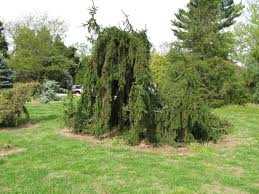The Weeping Norway Spruce is a popular tree in North America. For more information on choosing the right variety and care tips read our guide for the facts…
The weeping Norway spruce is an evergreen conifer with the scientific name Picea. Unlike most spruce trees which grow tall and straight, the untrained weeping Norway spruce will reach a height of about three feet. Trained trees may grow as tall as six feet. Like all weeping trees, the branches bend toward the ground and in this spruce can reach lengths of 7 1/2 feet giving the tree the appearance of a ground cover or creeper.
Training the Weeping Spruce
Young trees can be trained by staking to an upright which will give the trees greater height. They generally look well in garden areas and they prefer full sunlight. Most will tolerate partial shade. The tips of branches can be pruned to give the trees the desired shape, and in small spaces, to prevent the tree from taking over the garden. The weeping Norway spruce tolerates cold temperatures well and is hardy in most areas of the United States. It requires an average amount of water and regular watering is recommended especially in arid areas.
Planting Conditions
The tree grows best in soils with an acidic to neutral ph and aside from training or pruning requires little care. Its relatively small size makes it a good choice for a container on a patio or balcony and it looks very attractive in rock gardens. If planted against a rock wall or trellis the branches will attach to and climb the wall like a climber and its evergreen color provides winter interest in gardens. Unlike many container plants, it does not have to winter indoors, but can be left on balconies or patios year round.
Choosing the Right Tree and the Right Spot
Placement of a weeping Norway spruce in a garden takes some planning and it is best to look at pictures of the tree before deciding its location. There are a number of different cultivars of the weeping spruce and it is best to check with a local nursery or gardening center on the best choice for a particular area of the country. If these sources are unable to provide advice, the agricultural extension of the state university is usually happy to assist gardeners in choosing plants.
Since the weeping Norway spruce does not grow from seeds, it is not restricted in any part of the United States. The tree is propagated through grafting and is fairly disease and pest free although it is subject to spider mites, spruce gall aphid and bud worm. The tree is not particularly fast growing, but enjoys a long life span. Most gardeners are pleased with the performance and appearance of the tree and it provides easy care color for city dwellers with balconies and patios.





